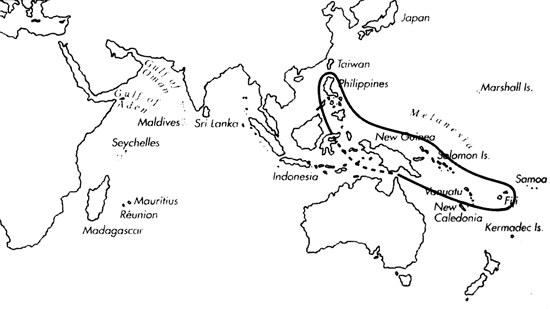Range: Philippines to Vanuatu and Fiji.
Description: Moderately small to medium-sized, conical to conoid- cylindrical; outline slightly convex, columella slightly deflected to left at siphonal fasciole. Shoulder angulate to subangulate, with about 12-17 tubercles. Spire of low to moderate height, outline concave. Larval shell with about 2 whorls, maximum diameter 0.8-0.9 mm. Postnuclear whorls tuberculate. Teleoconch sutural ramps flat with 0 increasing to 3-4 spiral grooves, sometimes with a few additional striae. Last whorl with widely to closely spaced, often granulose spiral ribs or ribbons either extending from base to shoulder or restricted to basal part; grooves between punctate or axially striate.
| Shell Morphometry | ||
|---|---|---|
| L | 25-45 mm | |
| RW | 0.10-0.24 g/mm | |
| RD | 0.53-0.63 | |
| PMD | 0.82-0.92 | |
| RSH | 0.08-0.21 | |
Ground colour white to light brown. Last whorl heavily clouded with yellowish to orangish brown; colour marking irregularly arranged or forming indistinct spiral bands on both sides of centre. Spiral rows of brown or orange dots and dashes extending from base to shoulder, varying from numerous to absent. Postnuclear sutural ramps with radial streaks matching last whorl pattern in colour, often as pronounced spots between tubercles. Aperture white to pale blue or violet.
Periostracum thin, translucent, and smooth.
Dorsum of foot white to cream, often darker marginally and anteriorly, radially mottled with brown on central and posterior parts; anterior part with light to dark brown spots concentrated centrally; a dotted to dashed dark brown pre-marginal line may be present. Sole of foot white, edged with cream. Rostrum brownish yellow, streaked with brown. Tentacles white, tipped with brown. Siphon white to cream, transversely mottled with brown, lighter and with less brown distally (Chaberman, pers. comm., 1981; Pl. 76, Fig. 53; Pl. 82, Fourth row, left).
Habitat and Habits: In 25-240 m; intertidal occurence (Cernohorsky, 1978) remains doubtful. In E. New Britain, it is found below 36 m on coarse sand at the foot of a reef (Richards, pers. comm., 1989). At Hansa Bay, it lives in coarse sand off reefs in 40-60 m (Chaberman, pers. comm., 1981). In Solomon Is., it occurs in 25-50 m.
Discussion: C. moluccensis is very similar in shell characters and in the colouration of the animal. It differs from C. proximus mainly in its multispiral (3.5 or more vs. 2 whorls) larval shell and in its larger size (to 60 mm). In Philippines, typical form occurs sympatrically with heavily sculptured shells (form cebuensis; Pl. 48, Figs. 12, 13) and shells with rather smooth last whorl (Pl. 48, Fig. 18). These forms intergrade in shell morphology and shell pattern.

C. proximus range map
This section contains verbatim reproductions of the accounts of 316 species of Conus from the Indo-Pacific region, from Manual of the Living Conidae, by Röckel, Korn and Kohn (1995). They are reproduced with the kind permission of the present publisher, Conchbooks.
All plates and figures referred to in the text are also in Röckel, Korn & Kohn, 1995. Manual of the Living Conidae Vol. 1: Indo-Pacific Region.
The range maps have been modified so that each species account has it own map, rather than one map that showed the ranges of several species in the original work. This was necessary because each species account is on a separate page on the website and not confined to the order of accounts in the book.